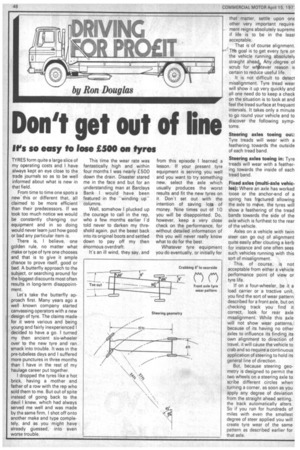Don't get out of line
Page 50

If you've noticed an error in this article please click here to report it so we can fix it.
Ws so easy to lose £500 on tyres
TYRES form quite a large slice of my operating costs and I have always kept an eye close to the trade journals so as to be well informed about what is new in that field.
From time to time one spots a new this or different that, all claimed to be more efficient than their predecessors. If we took too much notice we would be constantly changing our equipment and in so doing would never learn just how good or bad any particular item is.
There is, I believe, one golden rule, no matter what make or type of tyre one chooses and that is to give it ample chance to prove itself, good or bad. A butterfly approach to the subject, or searching around for the biggest discounts most often results in long-term disappointment.
Let's take the butterfly approach first. Many years ago a well known company started canvassing operators with a new design of tyre. The claims made for it were various and being young and fairly inexperienced I decided to have a go. I turned my then ancient six-wheeler over to the new tyre and ran. smack into trouble. It was in the pre-tubeless days and I suffered more punctures in three months than I have in the rest of my haulage career put together.
I dropped the tyres like a hot brick, having a mother and father of a row with the rep who sold them to me. But out of spite instead of going back to the devil I knew, which had always served me well and was made by the same firm, I shot off onto another make and type completely, and as you might have already guessed, into even worse trouble. This time the wear rate was fantastically high and within four months I was nearly £500 down the drain. Disaster stared me in the face and but for an understanding man at Barclays Bank I would have been featured in the "winding up" columns.
Well, somehow I plucked up the courage to call in the rep, who a few months earlier I'd told never to darken my threshold again, put the beast back into its original boots and settled down to pay off my then enormous overdraft.
It's an ill wind, they say, and from this episode I learned a lesson. If your present tyre equipment is serving you well and you want to try something new, select the axle which usually produces the worst results and fit the new tyres on it. Don't set out with the intention of saving lots of money. Nine times out of 10 you will be disappointed. Do, however, keep a very close check on the performance, for without detailed information of this you will never really know what to do for the best.
Whatever tyre equipment you do eventually, or initially for that matter, settle upon one other very important requirement reigns absolutely supreme if life is to be in the least acceptable.
That is of course alignment. The goal is to get every tyre on the vehicle running absolutely straight ahead. Any degree of scrub for whiltever reason is certain to reduce useful life.
It is not difficult to detect misalignment. Tyre tread wear will show it up very quickly and all one need do to keep a check on the situation is to look at and feel the tread surface at frequent intervals. It takes only a minute to go round your vehicle and to discover the following symptoms.
Steering axles toeing ow:: Tyre treads will wear with a feathering towards the outside of each tread band.
Steering axles toeing in: Tyre treads will wear with a feathering towards the inside of each tread band.
Fixed axles (multi-axle vehicles): Where an axle has worked loose or the anchor-end of a spring has fractured allowing the axle to move, the tyres will show a feathering of the tread bands towards the side of the axle which is furthest to the rear of the vehicle.
Axles on a vehicle with twin steer can go out of alignment quite easily after clouting a kerb for instance and one often sees such vehicles running with this sort of misalignment.
This, of course, is not acceptable from either a vehicle performance point of view or tyre life.
If on a four-wheeler, be it a load carrier or a tractive unit, you find the sort of wear pattern described for a front axle, but on checking track you find it correct, look for rear axle misalignment. While this axle will not show wear patterns, because of its having no other axles to influence its finding its own alignment to direction of travel, it will cause the vehicle to crab and so require a continuous application of steering to hold its general line of direction.
But, because steering geometry is designed to permit the two wheels on a steering axle to scribe different circles when turning a corner, as soon as you apply any degree of deviation from the straight ahead setting, the track automatically alters. So if you run for hundreds of miles with even the smallest degree of steer applied you will create tyre wear of the same pattern as described earlier for that axle.




























































































